Pre-Federalism Era began
1142-1789
The time period before the U.S. Constitution was ratified by the states.
“’The Great Law’ – Injunuity,” Vision Maker Media, November 12, 2013, https://www.youtube.com/watch?v=L1V5VeRdMnI.
Haudenosaunee Confederacy founded
1142
Five separate Native American nations—Mohawks or Kanienkehaka, Onondaga, Cayuga, Oneida, and Seneca—joined to form the Haudenosaunee Confederacy. The Haudenosaunee Confederacy Constitution, also known as the “Great Law of Peace,” was created to ensure each nation would maintain its own leadership but that common causes would be decided by a Grand Council of Chiefs.
Sources: Field Museum and PBS

Haudenosaunee shared ideas with American Founding Fathers
1754-1787
The Haudenosaunee Confederacy was a model for the federal system of government of the United States. In 1754, Haudenosaunee leaders attended the Albany Congress. Benjamin Franklin incorporated ideas from the Haudenosaunee Confederacy into the Albany Plan of Union, which he drafted to try to unite the colonies against foreign powers. In 1776, Iroquois representatives met with the Continental Congress at what is now Independence Hall. In 1785, Thomas Jefferson, James Madison, and James Monroe visited the Haudenosaunee to study their confederation. The Framers incorporated ideas shared by the Haudenosaunee in the United States Constitution in 1787.
Source: United States Senate

Constitutional Convention
1787
The Framers of the Constitution met in Philadelphia and drafted the United States Constitution. They considered and debated ideas about the structure of government they learned from Enlightenment thinkers such as Thomas Hobbes, John Locke, Charles Montesquieu, and Jean-Jacques Rousseau. Ultimately, they created a federal system of government in which powers and duties were divided between the federal (national) and state governments.
Source: Constitutional Rights Foundation

The Enumerated Powers of Congress
September 17, 1787
Article 1, Section 8 of the Constitution established the enumerated (listed) powers of Congress. Clauses 1–17 list specific congressional powers. Clause 18, known as the Necessary and Proper Clause, permits Congress to make all laws “necessary and proper” to carry out the enumerated powers. This clause is also known as the Elastic Clause because it is used to expand or stretch federal powers further than the 17 specific powers listed in the Constitution.
Source: Congress.gov
Related Inquiry Packs:
Article 4: Relations Between Governments
September 17, 1787
Article 4 of the Constitution addressed relations among the states and between the federal and state governments. The Full Faith and Credit Clause (Section 1) ensures that records of births and marriages and court orders originating in one state would be valid in all states. The Privileges and Immunities Clause (Section 2) prohibits states from denying out-of-state citizens their fundamental rights. These two clauses help explain how states interact with each other.
Source: Congress.gov
Related Inquiry Packs:

The Supremacy Clause
September 17, 1787
The Supremacy Clause established the Constitution and federal law as the supreme law of the land. This means that in the event of a conflict with state law, federal law is superior.
Sources: Congress.gov and LandmarkCases.org
Related Inquiry Packs:
Dual Federalism I Era began
1789-1865
During the time period, the federal government and state governments exercised almost exclusive authority over their areas of jurisdiction. There was little collaboration between the federal and state governments.
10th Amendment Ratified
December 15, 1791
The 10th Amendment is sometimes called the “states’ rights amendment” because it reserves all the powers not delegated to the federal government (Article 1, Section 8) or deemed “necessary and proper” by the Elastic Clause (Article 1, Section 8, Clause 18), to the states or the people.
Source: Congress.gov
Related Inquiry Packs:
“Marbury vs. Madison: The Empowerment of the Judiciary,” Supreme Court Historical Society, October 19, 2022, https://youtu.be/jqiHy4QSdqg
Marbury v. Madison: judicial review
February 24, 1803
The decision in Marbury v. Madison established judicial review, one of the most significant principles of American constitutional law. In this case the Supreme Court ruled that it is the Court itself that has the final say on what the Constitution means. The Supreme Court also has the final say in whether an act of government—legislative or executive at the federal, state, or local level—violates the Constitution.
Source: United States Government: Our Democracy (McGraw Hill Education)
Fletcher v. Peck: first state law struck down as unconstitutional
March 16, 1810
In this precedent-setting case, the Supreme Court ruled a state law unconstitutional for the first time. It struck down a Georgia law that took away land from buyers to whom the Georgia legislature had sold the same land the previous year.
Source: New Georgia Encyclopedia

McCulloch v. Maryland: implied powers recognized, national supremacy reinforced
March 6, 1819
In 1791, Congress created the First Bank of the United States. Many people opposed it because the Constitution did not expressly give Congress the power to create banks. However, supporters argued the Necessary and Proper Clause gave the federal government an “implied” power because Congress had the power to regulate trade, coin money, impose taxes, and spend money. The charter of the First Bank expired, and Congress created the Second Bank. Maryland attempted to close the branch by requiring all banks created outside of the state to pay a large tax. McCulloch, the manager of the Baltimore branch, refused to pay the tax. The state of Maryland sued McCulloch. The case was appealed to the Supreme Court asking: Does the Constitution allow Congress to create a national bank? If so, does Maryland have the power to tax a branch of the national bank within the state borders?
The Supreme Court unanimously decided that Congress had an implied power to create a national bank. The Court ruled that the Necessary and Proper Clause allows Congress to do more than the Constitution expressly authorizes, and Congress can enact laws that will help achieve Congress’ enumerated powers. By reinforcing that Congress had implied powers that were not explicitly listed in the Constitution, McCulloch v. Maryland greatly increased the powers of the federal government.
Source: United States Government: Our Democracy (McGraw Hill Education)
Related Inquiry Packs:
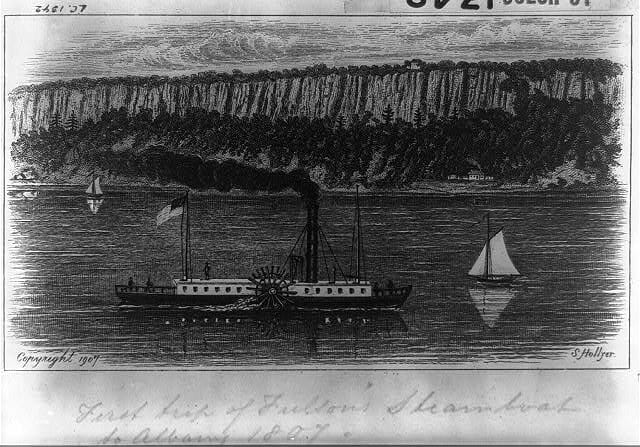
Gibbons v. Ogden: transportation is interstate commerce
March 2, 1824
This case clarified that the authority of Congress to regulate interstate commerce (between states) includes the authority to regulate intrastate commercial activity (within one state), like transporting goods and people, that relates to interstate commerce. The Gibbons decision says that only Congress can regulate commercial activity that is both intrastate and interstate. The decision increased federal authority to regulate transportation.
Source: United States Government: Our Democracy (McGraw Hill Education)
Related Inquiry Packs:
Barron v. Baltimore: Bill of Rights applies only to the federal government
February 16, 1833
In this case, the Supreme Court ruled that the Fifth Amendment’s provision that the government must pay if it takes private property did not apply to state governments. Barron v. Baltimore was decided before the 14th Amendment was added to the Constitution, and, at the time, the decision supported the view that the Bill of Rights only protected people from the federal government, not state governments.
Source: United States Government: Our Democracy (McGraw Hill Education)
“The Dred Scott Decision Featuring Justice Neil M. Gorsuch,” National Constitution Center, February 24, 2021, https://www.youtube.com/watch?v=iXGY48mnZlk.
Dred Scott v. Sandford: Missouri Compromise struck down
March 6, 1857
The decision in this case struck down the Missouri Compromise, which prohibited slavery in some territories. The Court ruled that because slavery was mentioned in the Constitution, Congress could not prohibit it. The Dred Scott decision restricted the federal government from passing laws about slavery in states and territories. It was also the opinion of the Court that an enslaved person was property, not a citizen, and therefore had no rights under the Constitution. The Court’s decision was met with outrage in the North and was a factor precipitating the Civil War.
Sources: Center for the Study of Federalism and United States Government: Our Democracy (McGraw Hill Education)
Dual Federalism II Era began
1865-1901
The federal government and state governments exercised almost exclusive authority over their areas of jurisdiction. During this era, the federal government began to take more control in some areas.

14th Amendment Ratified
July 9, 1868
Originally, the Bill of Rights only protected citizens from acts of the federal government. After the Civil War, the 14th Amendment was ratified to guarantee citizenship to enslaved people and establish birthright citizenship. The 14th Amendment also extended fundamental freedoms by prohibiting states from passing or enforcing laws that conflicted with those established in the Constitution. It also prohibited states from depriving citizens of due process of law (Due Process Clause) and denying them equal protection of the law (Equal Protection Clause). Over time, many cases came before the Supreme Court that also prohibited state governments from infringing on the rights found in the Bill of Rights. This process was called “selective incorporation” or simply “incorporation.” The 14th Amendment greatly increased the federal government’s role in protecting citizens’ rights from state laws and actions.
US v. EC Knight: Congress cannot regulate manufacturing
January 21, 1895
In this case, known as the “Sugar Trust Case”, the Supreme Court ruled that Congress could not regulate manufacturing (the making of goods) because it was not interstate commerce. Congress could not use the Commerce Clause, which only permitted federal regulation of the buying, selling, and transportation of goods between the states, to justify its regulation. This decision severely limited the federal government’s power for a time. It was effectively overturned in the 1930s.
Sources: Thirteen/WNET New York and Annenberg Classroom
Cooperative Federalism Era began
1901-1960
The federal government and state governments coordinated efforts and their jurisdictions overlapped.
Lochner v. New York: Lochner Era began, striking down labor regulations
April 17, 1905
The Supreme Court found that a New York law limiting bakers’ hours was unconstitutional. It found that the 14th Amendment protected the bakers’ freedom to enter into a contract to buy and sell labor, a fundamental freedom protected by the 14th Amendment. This decision began a period known as the “Lochner Era” in which the Supreme Court regularly struck down economic and labor regulations. This decision limited the federal government’s power and reaffirmed the states’ authority to regulate labor. The Lochner Era ended in 1937 with the decision in West Coast Hotel v. Parrish.
Sources: Thirteen/WNET New York

Hammer v. Dagenhart: production is not commerce
June 3, 1918
Congress passed the Keating-Owen Child Labor Act of 1916 to ban interstate shipment of goods made by child laborers. Congress used the Commerce Clause to justify this federal legislation. The Keating-Owen Act was challenged by the father of a child worker and eventually brought before the Supreme Court. In Hammer v. Dagenhart, the Court ruled against Congress and struck down the act. The Court reasoned that production was not commerce; therefore, Congress could not regulate it because regulating production was reserved to the states through the 10th Amendment. This decision restricted the power of the federal government to enact labor regulations.
Source: Oyez
“Incorporation | BRI’s Homework Help Series,” Bill of Rights Institute, September 15, 2022, https://www.youtube.com/watch?v=4vT_HdOY-Cw.
Selective Incorporation
1925-2019
In 1925, the Supreme Court ruled in what is considered the first incorporation case, Gitlow v. New York. The ruling established that states were required to ensure citizens’ First Amendment protection of free speech signaling a shift in the Court’s position. Over time the Supreme Court has applied almost all of the Bill of Rights protections to the states using the 14th Amendment’sDue Process Clause through incorporation.
In 1937, the Supreme Court explained how they would apply the incorporation doctrine and decide whether a right should be incorporated against the states. In future cases, the Supreme Court would weigh whether that right is “fundamental to our scheme of ordered liberty” and “deeply rooted in this Nation’s history and tradition.” The Court used this “test” to try to ensure the protection of basic rights did not vary from state to state. Because the incorporation of rights was accomplished over many years and on a case-by-case basis, the process is known as selective incorporation.
Through selective incorporation, the Supreme Court, and therefore the federal government, assumed an increased role in establishing rights. Some important incorporation cases involve the following rights:
- Freedom of press (Near v. Minnesota, 1931),
- right to counsel in capital cases (Powell v. Alabama, 1932),
- freedom of assembly (DeJonge v. Oregon, 1937),
- freedom of religion (Cantwell v. Connecticut, 1940),
- prohibiting the establishment of religion (Everson v. Board of Education, 1947),
- protection from illegal searches (Mapp v. Ohio, 1961),
- protection from cruel and unusual punishment (Robinson v. California, 1962),
- right to counsel in non-capital felony cases (Gideon v. Wainwright, 1963),
- right to a speedy trial (Klopfer v. North Carolina, 1967),
- protection against double jeopardy (Benton v. Maryland, 1968),
- right to keep and bear arms (McDonald v. Chicago, 2009),
- and most recently the protection from unreasonable fines (Timbs v. Indiana, 2019).
Sources: Legal Information Institute (Cornell Law School)
Related Inquiry Packs:
Social Security Act of 1935
August 14, 1936
On August 14, 1935, President Franklin D. Roosevelt signed the Social Security Act into law to provide relief from the economic suffering during the Great Depression. The act created a social insurance program to give benefits to retired workers, unemployment insurance, aid to dependent children, old-age benefits, and grants to states to provide medical care. The passage of this act marked the first time the federal government entered into many of these areas.
Source: Social Security Administration
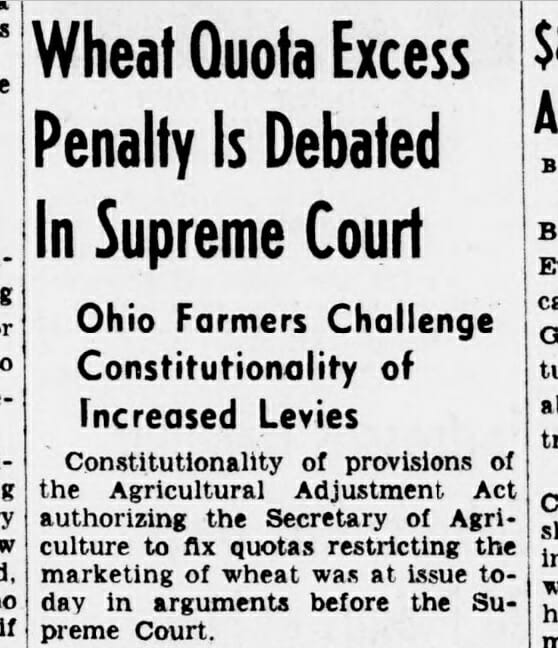
Wickard v. Filburn: Agricultural Adjustment Act upheld
November 9, 1942
In 1938, Congress passed the Agricultural Adjustment Act (AAA), which put limits on how much wheat farmers could harvest each year. Filburn, a small Ohio farmer, harvested more wheat than his limit and was fined. He claimed that he intended to use the wheat for personal use, not to sell or trade. He argued that he should not be penalized because his wheat would not impact interstate commerce. Filburn challenged the law as an overreach of Congress’ commerce power.
The Supreme Court decided unanimously that the AAA was not an overreach of Congress’ commerce power. The decision was a turning point that dramatically increased the power of the federal government to regulate many aspects of industry through the Commerce Clause.
Sources: Britannica and Oyez
Related Inquiry Packs:

Civil rights movement
1954-1968
The civil rights movement of the 1950s and 60s was the fight led by African Americans, and later joined by others, to end racial discrimination and to achieve equal opportunities to their White counterparts. The movement used many strategies to fight discrimination, such as legislation, Supreme Court challenges, executive orders, and non-violent resistance. Some federal laws and court decisions banned discrimination by state and local governments.
Sources: United States Government: Our Democracy (McGraw Hill Education)
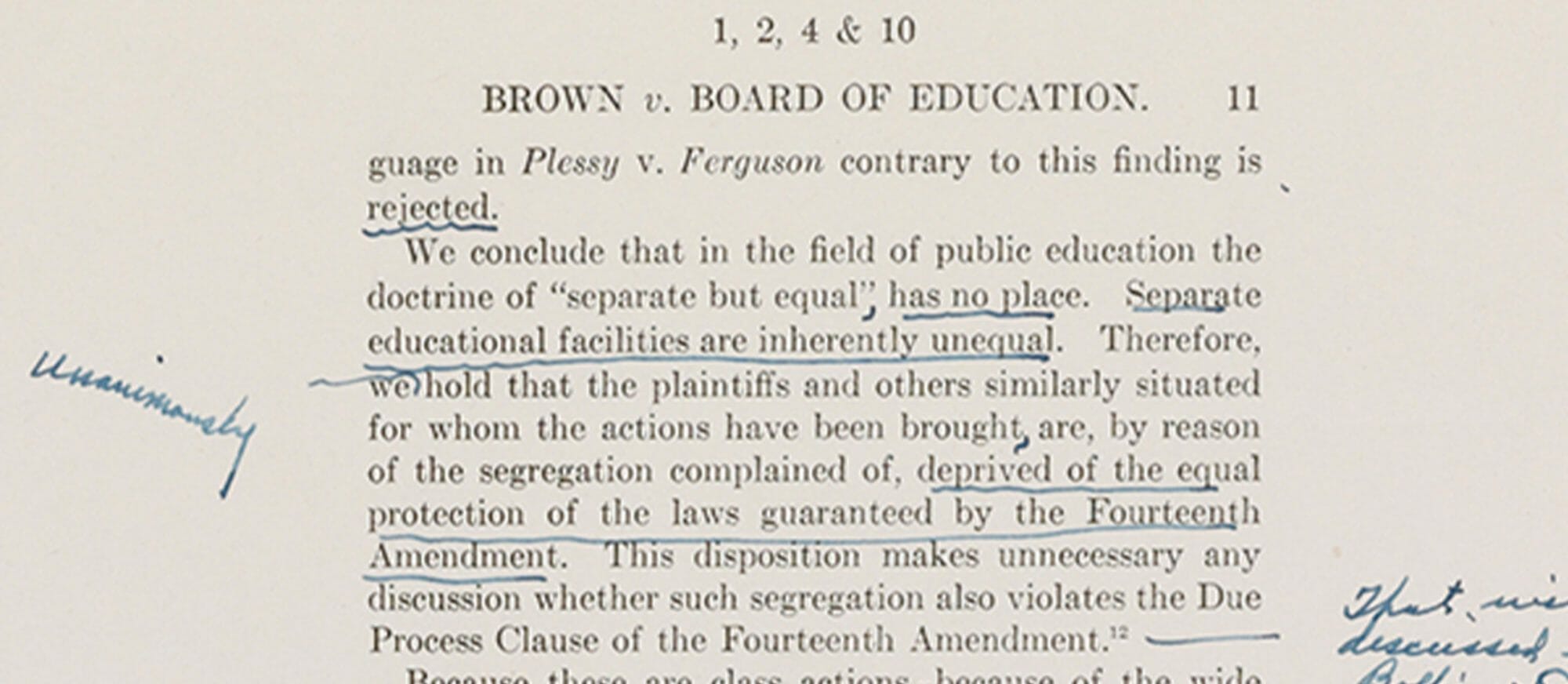
Brown v. Board of Education (I): public school desegregation
May 17, 1954
In the early 1950s, segregation in schools and other public facilities was legal because of past court decisions called precedents. In 1896, the Supreme Court of the United States decided a case, Plessy v. Ferguson, in which the Court said that segregation was legal when the facilities for both White and Black people were similar in quality. Under segregation, all-White and all-Black schools sometimes had similar buildings, busses, and teachers, but often they were of lower quality in all-Black schools. Black children often had to travel far to get to their school, passing White schools on the way.
In Topeka, Kansas, a Black student named Linda Brown had to walk through a dangerous railroad to get to her all-Black school. Her family believed that segregated schools should be illegal and sued the school system (Board of Education of Topeka). The case went to the Supreme Court asking: Does segregation of public schools based on race violate the Equal Protection Clause of the 14th Amendment? The Supreme Court found unanimously that segregated public schools violated the Equal Protection Clause. As a result of this decision, all public schools had to desegregate.
Source: LandmarkCases.org
Related Inquiry Packs:
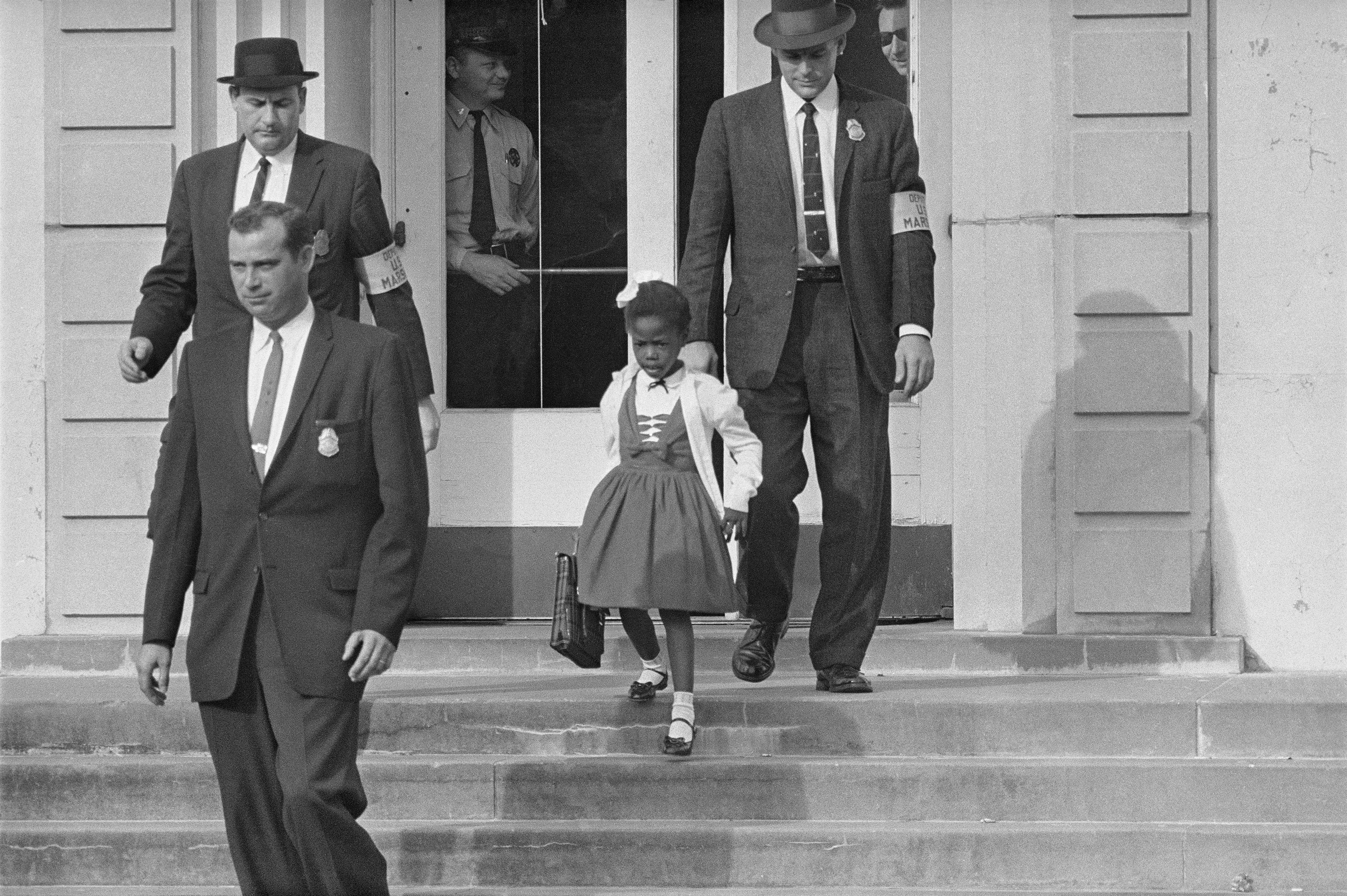
Brown v. Board of Education (II): schools must desegregate “with all deliberate speed”
May 31, 1955
After the Brown v. Board of Education of Topeka, Kansas decision, in a show of resistance, several states did not immediately desegregate their public schools. In 1955, a second case, Brown v. Board of Education of Topeka, Kansas II, directed schools and states to desegregate public schools “with all deliberate speed.”
Source: LandmarkCases.org
Creative Federalism Era began
1960-1970
During this period, the federal government created new programs and provided states with resources to implement them. Cooperation increased between federal and state governments. The federal government had an increased role.
The Great Society
The 1960s
“The Great Society” is the name given to President Lyndon B. Johnson’s policy initiatives with the goal of ending poverty, reducing crime, working toward equality, and improving the environment. Great Society programs and legislation include: Medicaid, Medicare, Elementary and Secondary Education Act (1965), Higher Education Act (1965), Head Start (1965), Clean Air Act (1965), Highway Safety Act (1966), Fair Packaging and Labeling Act (1966), Civil Rights Act (1964), and Voting Rights Act (1965). These programs extended the federal government’s authority in these areas, some of which were historically under the states’ authority.
Source: History.com
Landmark case decisions established "one person, one vote”
1962-1964
Landmark decisions in the Supreme Court cases Baker v. Carr (1962), Wesberry v. Sanders (1964), and Reynolds v. Sims (1964) established the principle of “one person, one vote,” or that individuals should have equal representation in voting. The Court used the 14th Amendment to justify their rulings that federal courts have jurisdiction over matters of redistricting, and states must establish numerical equality in electoral districts.
Source: Constitution Center

Civil Rights Act of 1964
July 2, 1964
Almost 100 years after the passage of the 14th Amendment, discriminatory state laws were still being passed and enforced and discrimination in public accommodations by private parties was legal. To combat this, the Civil Rights Act was proposed by President John F. Kennedy to give “all Americans the right to be served in facilities which are open to the public – hotels, restaurants, retail stores, and similar establishments” and to protect the right of all Americans to vote.
After Kennedy’s assassination, his successor President Lyndon B. Johnson urged the earliest possible passage of the civil rights bill. The Civil Rights Act gave the federal government authority to combat discrimination in public accommodations, public schools, and federal programs and was a victory for the civil rights movement.
Source: United States Government: Our Democracy (McGraw Hill Education)
Related Inquiry Packs:

Heart of Atlanta Motel v. US: public accommodations cannot discriminate on the basis of race
December 14, 1964
The Heart of Atlanta Motel refused to rent rooms to Black travelers in violation of the Civil Rights Act of 1964. The owner of the motel challenged the requirements of the act. He argued that the Civil Rights Act was unconstitutional because Congress exceeded its power under the Commerce Clause, as motels and restaurants are stationary and do not involve the exchange of goods, money, or services across state lines. The United States maintained that travelers from out of state were the most likely customers buying the services, which made public accommodations interstate commerce.
The Supreme Court decided unanimously for the United States in Heart of Atlanta Motel v. United States. The Court reasoned that since the motel was close to major interstate roads and received most of its business from out-of-state travelers, their refusal to serve Black travelers had an impact on interstate commerce; therefore, the use of the Commerce Clause was justified. The decision in this case increased the federal government’s authority to ensure that public accommodations did not discriminate on the basis of race.
Source: Library of Congress
Related Inquiry Packs:

Voting Rights Act of 1965
August 9, 1965
The Voting Rights Act of 1965 (VRA) was passed in response to voting discrimination, especially in Southern states. The VRA outlawed literacy tests and provided for the appointment of federal examiners who were empowered to register people to vote. Section 5 of the VRA required that nine states and their counties obtain “preclearance” from the U.S. District Court for the District of Columbia or the attorney general of the United States to ensure any proposed voting laws or procedures were not discriminatory. This changed the relationship between the federal government and state governments in regard to voting laws, giving the federal government more authority than it had historically.
Source: United States Government: Our Democracy (McGraw Hill Education)
Federal Fair Housing Act
April 11, 1968
The Federal Fair Housing Act of 1968 (part of the broader Civil Rights Act of 1968) forbids discrimination in the selling, leasing, or financing of housing based on the race, color, religion, sex, or national origin of the applicant. Amendments were added in 1988 to include protections for people with disabilities and families with children under 18 years old (with some exceptions including retirement communities).
Source: Street Law: A Course in Practical Law (McGraw Hill Education)
New Federalism/Devolution Era began
1970-present
During this current period, the process of creative federalism is reversing and authority is returning to states causing decentralization.

South Dakota v. Dole: Federal government may use fiscal federalism
June 23, 1987
Historically states set their own minimum drinking ages. This was considered a power reserved to the states in the 10th Amendment. In 1984, Congress passed the National Minimum Drinking Age Act. This law did not set a new national drinking age or directly change drinking ages in states. Instead—relying on the “spending clause” in Article 1 of the Constitution—the law indirectly encouraged states to raise the minimum drinking age to 21 by reducing federal highway funding by 5% to states with lower minimum drinking ages. South Dakota challenged the new federal law, arguing that it violated the 21st Amendment (which repealed prohibition) and amounted to federal “overreach” under the spending clause.
The Supreme Court decided that Congress had the authority to pass the law because it provided for the general welfare and that a 5% reduction in funding was not overly severe as to coerce states to change their laws. The decision opened the door for Congress to use “fiscal federalism” in which it influences states to change laws clearly under state authority by making it a condition for funding.
Source: Oyez
Unfunded Mandates Reform Act
March 22, 1995
An unfunded mandate is a regulation or requirement of a state or local government that is issued by the federal government but does not come with funding to help pay for it. The Unfunded Mandates Reform Act of 1995 was passed to limit the number of unfunded federal mandates the federal government could impose on state, local, and tribal governments. This act restricted the federal government from imposing federal mandates on states.

US v. Lopez: Devolution Revolution returns authority to the states
April 26, 1995
In 1990, Congress passed the Gun-Free School Zones Act (GFSZA), which prohibited people from knowingly carrying a gun in a school zone. This type of policing power was traditionally carried out by state or local governments. Lopez was convicted of possessing a gun at a Texas school. He appealed his conviction, arguing that Congress never had the authority to pass the GFSZA in the first place. The case went to the U.S. Supreme Court asking: Did Congress have the power under the Commerce Clause to pass the GFSZA?
The Court ruled that the federal government did not have the authority through the Commerce Clause to establish gun-free school zones. This decision signaled the beginning of the “Devolution Revolution,” which returned some powers once expanded to the federal governments to state and local governments.
Source: Oyez
Related Inquiry Packs:
US v. Virginia: federal government protects women’s rights
June 26, 1996
Virginia Military Institute (VMI) was the only single-sex school among Virginia's public institutions of higher education. The school was financially supported by and under the control of the Commonwealth of Virginia. Only men were admitted to the school. The attorney general of the United States filed a complaint on behalf of a female high school student seeking admission to VMI. The case went to the Supreme Court asking: Does Virginia's exclusion of women from VMI deny women capable of all the individual activities required by VMI cadets the equal protection of the laws guaranteed by the 14th Amendment?
The Supreme Court ruled that VMI's policy of admitting only men to the school violated the Equal Protection Clause and the civil rights of women wishing to attend the school. This decision is evidence of the Supreme Court’s expanded role in protecting civil rights of state citizens.
Source: Oyez
Related Inquiry Packs:
“Ending Welfare as We Knew It,” Retro Report, May 1, 2016, https://www.retroreport.org/education/video/public-policy-welfare-reform/.
Personal Responsibility and Work Opportunity Act
August 22, 1996
Block grants are federal funding given to states to achieve an outcome but with few strings attached about how the money must be spent. Block grants give states more autonomy (power within the state’s border) but require states to assume any costs above the amount of the block grant. In 1996, President Bill Clinton signed the Personal Responsibility and Work Opportunity Act, which replaced the existing Aid to Families with Dependent Children program with a block grant program, Temporary Assistance for Needy Families (TANF). Under TANF, states could use the block grant to run its own assistance programs as long as it followed some federal limits.
Sources: Ballotpedia and Retro Report
Printz v. US: federal government cannot mandate state employees
June 27, 1997
In 1993, the Brady Handgun Violence Prevention Act (known as the Brady Bill) was signed into law by President Bill Clinton. One provision of the law set up a temporary mandate, until a federal system could be established, that local chief law enforcement officers (CLEOs) would perform background checks before the sale of a handgun. County sheriffs challenged the constitutionality of the law, arguing that requiring state CLEOs to perform background checks exceeded the Necessary and Proper Clause. The Supreme Court ruled that state legislatures are not subject to direction by the federal government and cannot mandate state employees to fulfill federal tasks, even if it is only temporary. This decision restricted the federal government’s authority to create programs that state employees must implement.
Source: Oyez
US v. Morrison: Violence Against Women Act struck down
May 5, 2000
In 1994, Senator Joe Biden (D-Del.) sponsored the Violence Against Women Act (VAWA), which was ultimately passed and signed into law by President Bill Clinton as part of the Violent Crime and Law Enforcement Act. The law had several provisions, including one allowing women to sue their abusers in civil court whether or not the crime was prosecuted criminally. This provision was challenged in the Supreme Court by an accused abuser asking: Does Congress have the authority under the Commerce Clause to enact the VAWA? The Supreme Court struck down the provision allowing victims to sue in federal court finding that it exceeded Congress’ commerce power. This decision narrowed the use of the Commerce Clause by the federal government.
Source: Oyez
Related Inquiry Packs:
No Child Left Behind Act
January 8, 2002
The No Child Left Behind Act was signed by President George W. Bush in 2002. The law was designed to hold schools responsible for the academic progress of students measured through standardized testing. If states did not comply with the testing requirements, they would risk losing federal funds for schools. This law significantly increased the role of the federal government in education, an area historically controlled by the states.
Source: Education Week
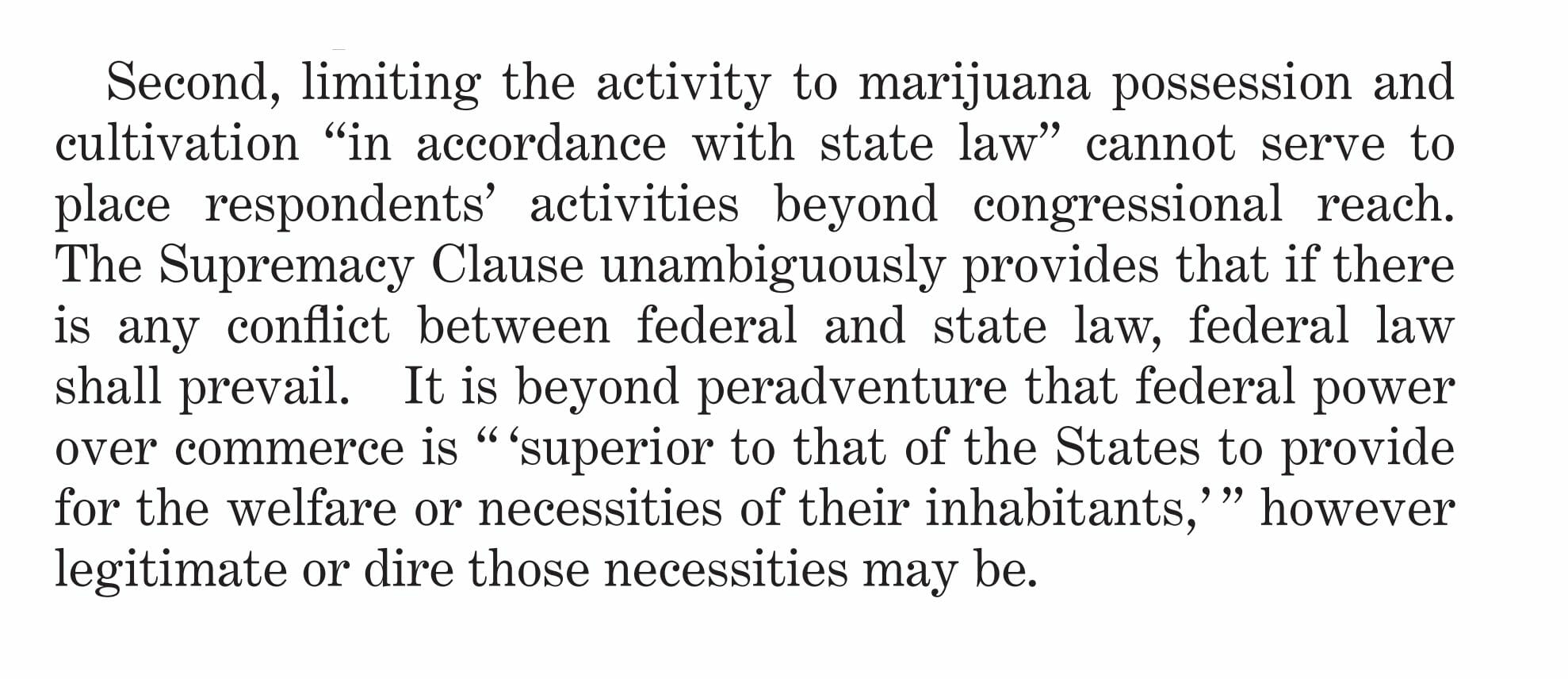
Gonzalez v. Raich: Congress can prohibit use of marijuana
June 6, 2005
The use of marijuana for medical purposes was legalized in California with the passage of the Compassionate Use Act (CUA) in 1996. This law conflicted with the federal Controlled Substances Act (CSA), which made the possession of marijuana illegal. The Drug Enforcement Agency seized marijuana from users in California who challenged the CSA as an overreach of the Commerce Clause. They argued that the act of growing and using marijuana for medicinal purposes did not substantially affect interstate commerce (trade) so could not be regulated by Congress.
The Supreme Court found that the Commerce Clause did give the federal government the authority to prohibit the cultivation and use of marijuana despite the California law legalizing it. The Court reasoned that use within California could potentially have an impact of the national marijuana market. Because the Supremacy Clause states that federal law and the Constitution are the “supreme law of the land,” the California law was struck down.
Source: Oyez
Related Inquiry Packs:
Patient Protection and Affordable Care Act (Obamacare)
March 23, 2010
In 2010, Congress passed the Patient Protection and Affordable Care Act, which set up a system known as “Obamacare.” Among other things, the law required large employers to provide access to health insurance for employees, expanded programs to assist the poor, and prohibited insurance companies from denying coverage or charging higher premiums to individuals with preexisting medical conditions. Congress set a requirement that all Americans (except prisoners and those with religious objections) purchase and maintain at least a minimum level of health coverage—known as the “individual mandate”—or be subject to a fine. Congress claimed the authority given to it by the Commerce Clause to pass this legislation. This marked an increased role by the federal government in what once was an unregulated and individual choice.
Source: U.S. Congress
Related Inquiry Packs:
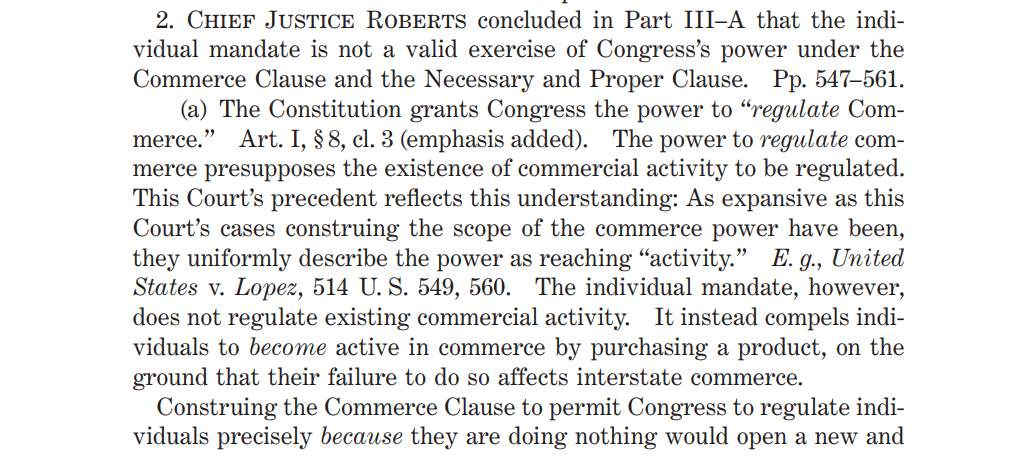
National Federation of Independent Business v. Sebelius: Affordable Care Act upheld as a tax
June 27, 2012
A group of 26 states, four people without health insurance, and the National Federation of Independent Business sued the federal government to stop the Patient Protection and Affordable Care Act from going into effect. They challenged several parts of the law, including the individual mandate requirement, as an overreach of the Commerce Clause. The case went to the Supreme Court asking: Does the individual mandate of the Affordable Care Act exceed the constitutional power of the federal government to regulate commerce?
A majority of the Court agreed that the individual mandate to purchase insurance was not a valid exercise of Congress’ commerce power; however, the Supreme Court upheld this provision under the taxing power of Congress.
Source: Library of Congress
Related Inquiry Packs:
Shelby County v. Holder: Section 5 of Voting Rights Act struck down
June 23, 2013
Shelby County, Alabama, challenged Section 5 of the Voting Rights Act of 1965 in Shelby County v. Holder. It argued that the provision of the Act, which required some states to submit districting plans to the Department of Justice for “pre-clearance”—while not requiring it of other states—was unconstitutional. Shelby County further argued that the 10th Amendment gave the power to regulate elections to the states.
The Supreme Court decided that the section of the Voting Rights Act that required pre-clearance was unconstitutional and struck this requirement down. This decision reduced the role of the federal government in voting regulations.
Source: Oyez
Related Inquiry Packs:

Obergefell v. Hodges: marriage equality nationwide
June 26, 2015
Between 1996 and 2005, several states enacted laws and passed constitutional amendments defining marriage as a union of one man and one woman. During that time, several states also passed laws legalizing same-sex marriage. However, even if a same-sex couple was legally married in a state that allowed same-sex marriage, their marriage might not be considered legitimate if they moved to a state that banned same-sex marriage.
Same-sex couples argued that banning same-sex marriage was unconstitutional. Some District Courts agreed, saying it was unfair to treat same-sex couples differently. Other courts upheld the bans. The Supreme Court was asked to hear many of these cases. It combined four cases into one argument under the name Obergefell v. Hodges. The case asked: Does the 14th Amendment require a state to license same-sex marriages? Does the 14th Amendment require a state to recognize a same-sex marriage that was lawfully licensed out of state?
The Supreme Court ruled for the same-sex couples stating that the Due Process Clause of the 14th Amendment protects fundamental liberties from government interference. The opinion went on to note that the Supreme Court has long held that marriage is one of these fundamental rights.
The decision also stated that the bans on same-sex marriage violated the Equal Protection Clause because the states’ marriage laws were in essence unequal. As a result of this decision many state laws and some state constitutional amendments were struck down, marking a shift in the authority to make law regarding marriage away from the states and toward the federal government.
Source: LandmarkCases.org

